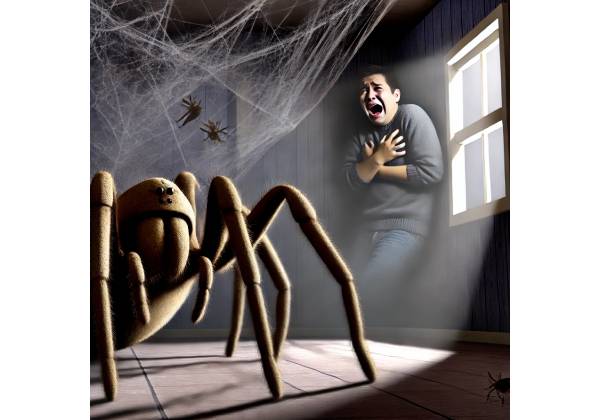
What is arachnophobia?
Arachnophobia is the intense and irrational fear of spiders, which affects millions of people worldwide. While it is normal to feel uneasy around spiders, those with arachnophobia experience severe distress, anxiety, and even panic when confronted with these creatures. The fear can be triggered by seeing a spider in person, encountering images of spiders, or simply thinking about them. In severe cases, people may avoid places or situations where they believe spiders might be present, such as basements, attics, or outdoor areas.
The term “arachnophobia” is derived from the Greek words “arachne,” meaning spider, and “phobos,” which means fear. Arachnophobia is classified as a specific phobia, which is a type of anxiety disorder that is specific to one object or situation—in this case, spiders. Though spiders are usually harmless, this phobia can cause excessive fear, causing significant distress in daily life.
For those suffering from arachnophobia, the fear can be crippling, affecting both their mental and emotional health. Fortunately, with the right treatment and support, people can overcome their fear of spiders and live a more balanced, anxiety-free life.
What are the symptoms of arachnophobia?
Arachnophobia causes a range of symptoms that affect people physically, emotionally, and behaviorally. While symptoms can vary in severity, they usually appear when a person encounters a spider, thinks about spiders, or anticipates being in a situation where spiders may be present. The following is a comprehensive list of the key symptoms of arachnophobia.
Physical Symptoms
Fear of spiders frequently activates the body’s “fight-or-flight” response, resulting in a variety of physical reactions. These symptoms appear when people feel threatened by the presence or thought of a spider.
- Increased heart rate (tachycardia): When confronted with a spider or even the image of one, people with arachnophobia may experience a fast heartbeat.
- Shortness of breath: The body’s fear response can cause shallow breathing or a feeling of being out of breath, especially if a spider is nearby.
- Sweating: Intense fear can cause sweating, especially in stressful situations like unexpectedly seeing a spider.
- Trembling or shaking: Many people who have arachnophobia experience involuntary tremors when they see or think about spiders.
- Dizziness or lightheadedness: The sudden onset of fear can cause a person to feel faint or disoriented, especially if the anxiety response is strong.
- Nausea or stomach discomfort: When someone with arachnophobia is exposed to spiders, they may experience nausea or an upset stomach, which are common physical reactions to extreme fear.
- Chest pain or tightness: Arachnophobia-induced anxiety can cause chest discomfort, which can mimic the symptoms of a heart attack.
Emotional and Psychological Symptoms
Arachnophobia has a significant impact on emotional well-being, causing distress that extends beyond normal fear. The emotional response can range between mild discomfort and overwhelming panic:
- Panic attacks: In severe cases, arachnophobia can cause panic attacks, which are marked by intense fear, a racing heart, difficulty breathing, and a sense of impending doom.
- Overwhelming fear or dread: Just thinking about spiders can cause feelings of dread, making daily activities difficult for those with severe arachnophobia.
- Anticipatory anxiety: People may feel anxious before encountering spiders, especially if they are entering areas where spiders are likely to be found, such as forests, basements, or old buildings.
- Helplessness or loss of control: When confronted with a spider, many people with arachnophobia feel helpless, fearing they will be unable to protect themselves or flee the situation.
- Shame or embarrassment: Some people are embarrassed about their fear of spiders, especially if they believe others will judge them for having such a strong reaction to something that is normally harmless.
Behavioral Symptoms
Many people with arachnophobia develop avoidance behaviors to cope with their fear of spiders, which can significantly limit their daily activities.
- Avoiding areas where spiders may be present: People should avoid basements, attics, gardens, and sheds where spiders are likely to be found. This can result in missed opportunities for social, recreational, or professional activities.
- Refusing to participate in outdoor activities: Many people avoid hiking, camping, and other outdoor activities because they are afraid of encountering spiders in their natural habitat.
- Excessive cleaning or spider inspection: Some people may clean or inspect their living spaces on a regular basis to ensure that there are no spiders. This can be time consuming and stressful.
- Relying on others to handle spiders: Arachnophobics may refuse to touch or be near spiders, instead relying on friends or family members to remove them from their surroundings.
Cognitive symptoms
Arachnophobia also influences cognitive processes, resulting in distorted thoughts and exaggerated fears of spiders:
- Catastrophic thinking: People may believe spiders are much more dangerous than they are, exaggerating the threat posed by even small or harmless species.
- Hypervigilance: Many people with arachnophobia become overly alert in places where spiders may be present, constantly scanning their surroundings for any sign of a spider.
- Intrusive thoughts: Repeated, unwanted thoughts about spiders can take over a person’s mind even when no immediate threat exists. These thoughts can be upsetting and challenging to manage.
Recognizing the various symptoms associated with arachnophobia is the first step toward better understanding the condition and seeking treatment. Individuals can better manage their phobia by identifying both physical and emotional responses to it.
Causes and Risk Factors for Arachnophobia
Arachnophobia, like other specific phobias, arises from a combination of psychological, environmental, and biological factors. Understanding the causes and risk factors can help explain why some people develop a strong fear of spiders while others don’t.
Psychological Causes
- Traumatic experiences: Arachnophobia can develop as a result of a traumatic event involving spiders, such as being bitten by one or encountering one unexpectedly. Even witnessing another person’s unpleasant encounter with a spider can instill a lasting fear.
- Learned behavior: Phobias can be acquired through observation. For example, if a child grows up in a home where one parent has a strong fear of spiders, the child may internalize that fear and develop arachnophobia.
- Negative associations: Some people develop arachnophobia as a result of negative associations formed as children or young adults. These associations may be related to cultural or social attitudes toward spiders, which are frequently depicted as dangerous or creepy.
Environmental Factors
- Cultural influences: Some cultures regard spiders with fear and suspicion, which can contribute to the development of arachnophobia. Media representations, such as horror films or stories about venomous spiders, can exacerbate fear.
- Lack of exposure: People who have had little exposure to spiders or have never learned to recognize harmless species may develop an exaggerated fear of them. This lack of familiarity can make spiders appear more dangerous than they are.
Biological and Genetic Factors
- Evolutionary predisposition: Some researchers believe that humans are genetically predisposed to fear spiders. Throughout human history, avoiding potentially dangerous animals like venomous spiders would have provided a survival advantage. Although most spiders today pose little to no threat, this deeply ingrained fear may persist in modern humans.
- Genetic predisposition: Phobias, including arachnophobia, may have a genetic basis. Individuals with a family history of anxiety disorders, depression, or specific phobias are more prone to developing arachnophobia.
Risk Factors
Certain factors raise the risk of developing arachnophobia:
- A personal or familial history of anxiety disorders or phobias.
- Previous negative experiences with spiders.
- Being raised in an environment where spiders are considered dangerous or frightening.
- Cultural influences that instill fear of spiders
Understanding the causes and risk factors of arachnophobia allows for a better understanding of why this fear develops and how it can be addressed through targeted treatment.
How is arachnophobia diagnosed?
Arachnophobia is diagnosed after a thorough evaluation by a mental health professional, such as a psychologist or psychiatrist. The diagnostic process focuses on determining the severity of the individual’s fear, how it affects their daily life, and any underlying causes that may have contributed to the phobia’s development.
Diagnostic Criteria
Arachnophobia is listed as a specific phobia in the Diagnostic and Statistical Manual of Mental Disorders (DSM-5). To satisfy the diagnostic criteria, the following conditions must be present:
- Persistent and excessive fear of spiders that outweighs any actual threat they pose.
- Avoidance of spiders or spider-infested situations, which can cause significant distress or impair daily functioning.
- The fear or anxiety persists for six months or more and is not caused by another mental health disorder, such as generalized anxiety disorder or obsessive-compulsive disorder (OCD).
Clinical Interviews
Mental health professionals conduct in-depth clinical interviews to assess an individual’s fear of spiders. These interviews focus on when the fear first appeared, the severity of the symptoms, and how the phobia affects the individual’s life. Clinicians also inquire about any prior interactions with spiders that may have contributed to the development of arachnophobia.
Psychological Assessments
In some cases, standardized questionnaires or psychological assessments may be used to determine the severity of the phobia. Tools such as the Spider Phobia Questionnaire (SPQ) can aid in quantifying an individual’s fear and avoidance behaviors. These assessments provide valuable information about how arachnophobia affects a person’s quality of life.
Rules Out Other Conditions
Because arachnophobia shares symptoms with other anxiety-related disorders, mental health professionals must rule out other possible diagnoses. This includes distinguishing arachnophobia from disorders like generalized anxiety disorder (GAD), social anxiety disorder, or post-traumatic stress disorder (PTSD), which all involve anxiety but are triggered by broader or different circumstances. A thorough evaluation ensures that the diagnosis is limited to arachnophobia and not part of a larger mental health issue.
Once arachnophobia has been properly diagnosed, a treatment plan can be created to address the phobia’s specific symptoms and fears.
Effects of Arachnophobia on Daily Life
Arachnophobia can have a significant impact on many aspects of a person’s daily life, limiting their ability to function properly. Fear of spiders can cause avoidance behaviors that extend beyond encounters with live spiders, affecting social, personal, and professional domains.
Social Limitations
- Avoidance of social activities in outdoor or rural areas: People with arachnophobia may avoid outdoor gatherings, camping trips, or any other situation where spiders are likely to be present. This can result in social isolation and missed opportunities to communicate with friends and family.
- Impact on relationships: Fear of spiders can strain relationships, especially if friends, partners, or family members do not fully comprehend the severity of the phobia. Individuals may be embarrassed or frustrated by their reactions, which can lead to communication breakdowns or conflict in close relationships.
Professional and Academic Challenges
Arachnophobia can also interfere with a person’s professional life, especially if their job requires them to work outdoors, travel, or be in environments where spiders are common.
- Difficulty performing work duties: People with arachnophobia may struggle in jobs that require them to work in basements, attics, or outside. In some cases, fear may prevent them from accepting specific jobs or promotions.
- Impaired academic performance: Arachnophobia can prevent students from participating in outdoor field trips, biology courses with spiders, or science labs that require specimen handling.
Emotional and psychological strain
Living with a persistent fear of spiders can cause ongoing emotional and psychological distress.
- Chronic anxiety: The fear of encountering spiders, even in areas where they are unlikely to be found, can cause a constant state of worry and hypervigilance. This increased anxiety may affect daily activities such as cleaning the house or walking through the garden.
- Depression or low self-esteem: People who have severe arachnophobia may feel isolated or frustrated because they are unable to engage in normal activities. The constant avoidance of environments where spiders may be present can result in feelings of hopelessness or worthlessness.
- Embarrassment or shame: Many people with arachnophobia are embarrassed by the severity of their fear, especially if they believe others will judge them for overreacting to spiders. This can lead to social isolation or a reluctance to seek help.
Everyday Limitations
Even routine tasks can be difficult for those with arachnophobia, as the fear of encountering spiders pervades daily life:
- Avoidance of specific rooms or areas in the home: People who have arachnophobia may avoid areas where spiders are commonly found, such as basements, garages, or attics. This may limit their ability to clean, store items, or perform household maintenance tasks.
- Changes in daily routines: Fear of spiders can cause people to change their routines, such as avoiding morning walks in wooded areas or thoroughly inspecting rooms before entering.
- Extreme measures to prevent encounters: Some people will go to great lengths to keep spiders out of their home or workspace, including frequent cleaning, pest control measures, and inspections that add stress to their daily routine.
Understanding how arachnophobia affects daily life emphasizes the importance of getting help. While some people’s fear of spiders may appear manageable, it can pose significant barriers to living a fulfilling and balanced life.
Top Treatment Options for Arachnophobia
Arachnophobia can be extremely distressing, but it is a highly treatable condition. A combination of psychological therapies, exposure techniques, and, in some cases, medication can help people overcome their fear of spiders and reclaim control of their lives. Here are some of the most effective ways to manage arachnophobia.
Cognitive-Behavioral Therapy (CBT)
Cognitive Behavioral Therapy (CBT) is one of the most common treatments for phobias, including arachnophobia. CBT focuses on identifying and challenging the negative thought patterns that cause fear, assisting people in developing healthier coping mechanisms.
- Cognitive restructuring: This technique entails assisting individuals in challenging irrational thoughts about spiders, such as the belief that all spiders are dangerous or life-threatening. Individuals can reduce their fear response by replacing catastrophic thoughts with more rational ones.
- Exposure therapy: Exposure therapy is a key component of cognitive behavioral therapy for arachnophobia, in which people are gradually exposed to spiders in a controlled setting. Exposure usually starts with low-level triggers, like looking at spider pictures, and then progresses to more direct encounters, like observing a live spider from a safe distance. Over time, this desensitization process helps people overcome their fear of spiders.
- Behavioral experiments: CBT also includes behavioral experiments, in which people are encouraged to test their fears and assumptions about spiders in safe, controlled environments. This increases confidence and reduces avoidance behaviors.
Virtual reality exposure therapy (VRET)
Virtual Reality Exposure Therapy (VRET) is an innovative alternative for people who are not yet ready to face their fears in real-life situations. VRET simulates encounters with spiders in immersive virtual environments, allowing people to confront their fears in a safe digital space.
- Simulated spider encounters: VRET allows users to simulate various scenarios involving spiders, such as standing near a spider web or watching a spider crawl across the floor. These virtual scenarios are tailored to the individual’s fear level, allowing them to gradually increase tolerance.
- Safe and controlled exposure: VRET provides a safe environment for people to confront their fears without the immediate presence of a real spider, allowing them to progress through therapy at their own pace.
Eye movement desensitization and reprocessing (EMDR)
Eye Movement Desensitization and Reprocessing (EMDR) is a therapeutic technique that assists individuals in processing and reframing traumatic memories associated with spiders. EMDR is especially beneficial for people with arachnophobia caused by a specific traumatic event, such as being bitten by a spider.
- Processing traumatic memories: In EMDR, people focus on distressing memories while performing guided eye movements or other forms of bilateral stimulation. This process reduces the emotional intensity of the memory, allowing people to face their fears without being overwhelmed by past trauma.
- Desensitization: EMDR gradually helps people become desensitized to their fear of spiders, allowing them to engage in daily activities without experiencing overwhelming anxiety.
Medications
In some cases, medication may be prescribed to help manage arachnophobia symptoms, especially if the individual suffers from severe anxiety or panic. Medications are typically used in conjunction with therapy, rather than as a standalone treatment.
- Selective serotonin reuptake inhibitors (SSRIs): SSRIs like fluoxetine (Prozac) and sertraline (Zoloft) are commonly used to reduce anxiety and improve mood regulation. These medications can help people participate in therapy more effectively by lowering the intensity of their fear response.
- Benzodiazepines: To treat acute anxiety in the short term, benzodiazepines like lorazepam (Ativan) or diazepam (Valium) may be prescribed. However, due to their potential for dependence, these medications are typically used for short periods of time or in specific situations where people expect to encounter spiders.
- Beta-blockers: Beta-blockers, such as propranolol, can be used to treat physical symptoms of anxiety, such as trembling or a rapid heartbeat, during spider exposure or therapy.
Support Groups and Peer Support
Support groups allow people with arachnophobia to connect with others who have had similar experiences. Group therapy can offer emotional support, practical advice, and motivation to overcome a fear of spiders.
- Peer support: Participating in a support group allows people to share their fears and coping strategies with others who understand the difficulties of living with arachnophobia. This can help to reduce feelings of isolation and promote a sense of community.
- Group exposure therapy: In some cases, group therapy may include exposure exercises in which participants confront their fear of spiders together, allowing them to face their anxiety in a safe and collaborative environment.
Lifestyle Changes and Self-Help Strategies
In addition to formal treatment options, individuals with arachnophobia can incorporate lifestyle changes and self-help strategies to better manage their fear:
- Gradual exposure in daily life: People can practice exposing themselves to low-level triggers by observing small spiders in controlled environments or viewing spider pictures online. This gradual exposure helps them become desensitized to their fear over time.
- Relaxation techniques: Breathing exercises, meditation, and progressive muscle relaxation can help alleviate the physical symptoms of anxiety that arise when confronted with spiders. Practicing these techniques during exposure therapy can help you remain calm.
- Maintaining a healthy lifestyle: Regular exercise, a balanced diet, and adequate sleep all contribute to overall emotional well-being, making it easier to deal with anxiety and stress caused by arachnophobia.










